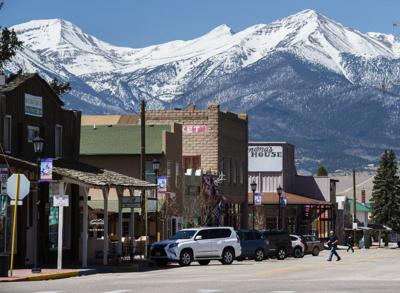The drive south starts out barren, the empty ribbons of dusty road carving through towns of crumbling buildings and rusting trailer homes, past barbed-wire fences wrapping open land and fields slowly turning green.
EDITOR’S NOTE: This article was written pre-COVID-19. Please follow all safety orders in place.
Soon the landscape warps. Now Colorado 96 climbs into the San Isabel National Forest, and the rock outcrops show off their shapes and colors, red and pink, gunpowder gray and green with lichen.
And then a great blue clearing: the Sangre de Cristos to the west, the Wet Mountains to the east. And in the middle of it all, a little street.
“We’re like a diamond in the rough,” says Wanda Jennings, the wide-smiling clerk at Westcliffe’s Town Hall. She brings my attention to the framed picture on the wall, capturing the scene just down the street: the valley floor and the white-capped peaks soaring behind it.

“I mean, where else can you go to get views like this?” she asks.
You must come here, to Westcliffe, a place hiding from population hubs: 75 miles from Colorado Springs; 55 miles from Pueblo; almost 50 miles from Salida.
“We’re at the end of the world a little bit,” says Maria Aulich, a Midwestern transplant fitting right in with the sizable portion of residents who came from afar, seeking to settle with the silence and beauty.
Says Twila Geroux, one with deep family roots in the valley: “We’re on the road to nowhere. You have to come find us.”
On paths, a town brochure borrows a line from Robert Frost: “I took the one less traveled by, and that has made all the difference.”
Joe Gromelski, 53, wanted something different. Five years ago, he was living in the Springs, tired of the sirens, the construction, the bad news on TV. Now he’s here behind the counter of a nostalgic pawn shop on Main Street, listening to Bob Dylan on the radio and greeting the trickle of customers. “How you doing, my friend?” he asks one. “Hey, pretty lady, what’s going on?” he asks another. “Hey ol’ buddy,” he says to a caller.
Gromelski’s sweetest childhood memories are in this town, where his grandfather built a cabin in the 1950s. He learned to fish as a boy in the area’s many alpine lakes, learned to drive on the back roads, learned to shoot a .22. “I wanted to come home,” he says.
Westcliffe is home to roughly 500 people, many of them active in the great outdoors. Indeed, the opportunities here are great. Nine 14,000-foot peaks lurk on this side of the Sangres, and the town serves as a gateway to the Rainbow Trail, spanning nearly 100 miles through the mountain range, connecting with trails to those grand summits. Bike rides can be customized from relaxing to rousing. Fishing is big, as is hunting, as are four-wheeling and camping.
The town prides itself on being “one of Colorado’s best-kept secrets.” Yet there’s a paradox, with the continued effort to market those natural offerings, and with all the talk in Town Hall about attracting tourists. Leaders want to see more young families, more permanent homes and fewer secondary homes. They’d like to attract more employers – Custer County and the K-12 schools in town (enrollment 393) are the best chances for work around here. More doctors are desired – a small medical center, unequipped for surgeries, is all the town has in the way of health care.
Constant concern focuses on seasonal business on Main Street, lined with art galleries and boutiques, souvenir shops and furniture stores, coffee joints and B&Bs.
“The challenge is keeping Main Street not vacant,” says Geroux, the former mayor pro tem who now sells ranching real estate. “Nobody wants a dead town.”
That sentiment is shared between small business owners and the larger ranching community, which profits in part from the land’s blessed horse hay, high in protein and shipped around the nation.
Also shared is a longing for the nearby ski area that once was. There was pushback to Conquistador’s modest development in the ’70s that led to three lifts. But when the area closed in 1988, some ranchers missed the supplemental income they got from work there. Businesses suffered.
“If we still had that ski area, this whole valley would be different,” says Rod Thornburg, a town trustee who came here from Oklahoma to be a ski bum.
I meet him on one of his last days as owner of the outdoor retailer on Main Street. He is silver-haired and ready for retirement. Running the business was hard. But he’s always been able to find serenity here, since his early days living in a remote cabin at 8,500 feet here, under the big sky that glimmers wildly at night.
Back at the pawn shop, Gromelski is working one of his four jobs. “That’s OK,” he says. “I’m not out for the dollar.”
And he’d rather Westcliffe stay as is, untouched by development, the views unobstructed – forever the picture kept in a frame.
“Look at that mountain range, and you never see the same thing twice,” he says. “This is peace here.”








(0) comments
Welcome to the discussion.
Log In
Keep it Clean. Please avoid obscene, vulgar, lewd, racist or sexually-oriented language.
PLEASE TURN OFF YOUR CAPS LOCK.
Don't Threaten. Threats of harming another person will not be tolerated.
Be Truthful. Don't knowingly lie about anyone or anything.
Be Nice. No racism, sexism or any sort of -ism that is degrading to another person.
Be Proactive. Use the 'Report' link on each comment to let us know of abusive posts.
Share with Us. We'd love to hear eyewitness accounts, the history behind an article.